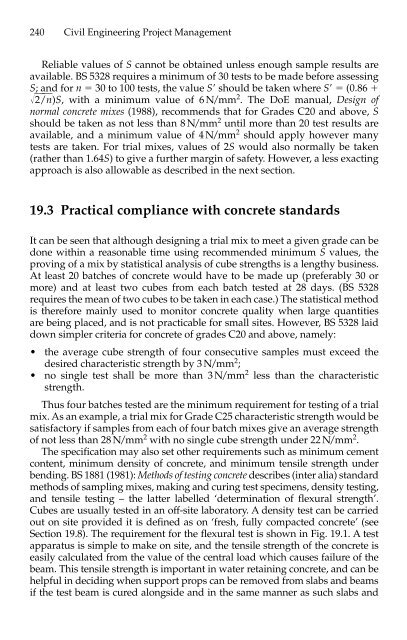Civil Engineering Project Management (4th Edition)
You also want an ePaper? Increase the reach of your titles
YUMPU automatically turns print PDFs into web optimized ePapers that Google loves.
240 <strong>Civil</strong> <strong>Engineering</strong> <strong>Project</strong> <strong>Management</strong><br />
Reliable values of S cannot be obtained unless enough sample results are<br />
available. BS 5328 requires a minimum of 30 tests to be made before assessing<br />
S; and for n 30 to 100 tests, the value S should be taken where S(0.86 <br />
2/n)S, with a minimum value of 6 N/mm 2 . The DoE manual, Design of<br />
normal concrete mixes (1988), recommends that for Grades C20 and above, S<br />
should be taken as not less than 8 N/mm 2 until more than 20 test results are<br />
available, and a minimum value of 4 N/mm 2 should apply however many<br />
tests are taken. For trial mixes, values of 2S would also normally be taken<br />
(rather than 1.64S) to give a further margin of safety. However, a less exacting<br />
approach is also allowable as described in the next section.<br />
19.3 Practical compliance with concrete standards<br />
It can be seen that although designing a trial mix to meet a given grade can be<br />
done within a reasonable time using recommended minimum S values, the<br />
proving of a mix by statistical analysis of cube strengths is a lengthy business.<br />
At least 20 batches of concrete would have to be made up (preferably 30 or<br />
more) and at least two cubes from each batch tested at 28 days. (BS 5328<br />
requires the mean of two cubes to be taken in each case.) The statistical method<br />
is therefore mainly used to monitor concrete quality when large quantities<br />
are being placed, and is not practicable for small sites. However, BS 5328 laid<br />
down simpler criteria for concrete of grades C20 and above, namely:<br />
• the average cube strength of four consecutive samples must exceed the<br />
desired characteristic strength by 3 N/mm2 ;<br />
• no single test shall be more than 3 N/mm2 less than the characteristic<br />
strength.<br />
Thus four batches tested are the minimum requirement for testing of a trial<br />
mix. As an example, a trial mix for Grade C25 characteristic strength would be<br />
satisfactory if samples from each of four batch mixes give an average strength<br />
of not less than 28 N/mm2 with no single cube strength under 22 N/mm2 .<br />
The specification may also set other requirements such as minimum cement<br />
content, minimum density of concrete, and minimum tensile strength under<br />
bending. BS 1881 (1981): Methods of testing concrete describes (inter alia) standard<br />
methods of sampling mixes, making and curing test specimens, density testing,<br />
and tensile testing – the latter labelled ‘determination of flexural strength’.<br />
Cubes are usually tested in an off-site laboratory. A density test can be carried<br />
out on site provided it is defined as on ‘fresh, fully compacted concrete’ (see<br />
Section 19.8). The requirement for the flexural test is shown in Fig. 19.1. A test<br />
apparatus is simple to make on site, and the tensile strength of the concrete is<br />
easily calculated from the value of the central load which causes failure of the<br />
beam. This tensile strength is important in water retaining concrete, and can be<br />
helpful in deciding when support props can be removed from slabs and beams<br />
if the test beam is cured alongside and in the same manner as such slabs and


















